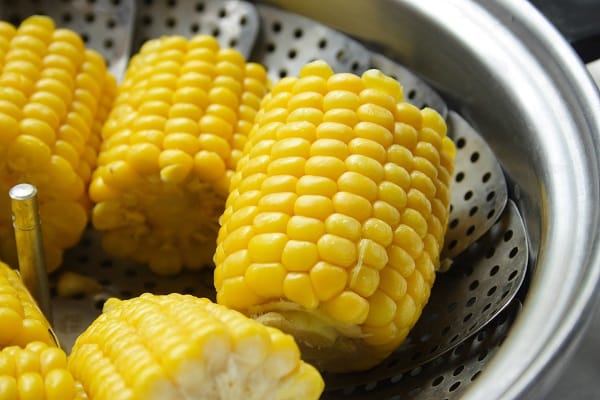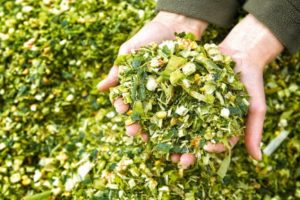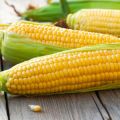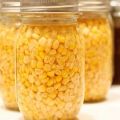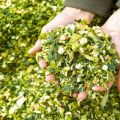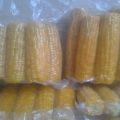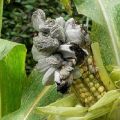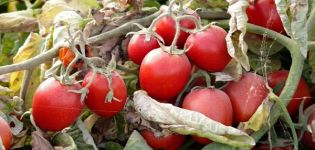Rules and terms for harvesting corn on the cob from the fields
Maize harvesting can be done in different ways. The grain crop is grown for silage or grain. And in both cases, the cleaning process has its own characteristics. The difference lies in the timing of the harvest, as well as in the choice of a combine harvester with special attachments. If the agrotechnical methods of growing crops and the rules for collecting finished products were followed, then the quantity and quality of the crop will please.
Stages of maize ripeness
Corn is harvested at different times, which depend on the intended purpose of the crop. There are several stages of grain crop maturity:
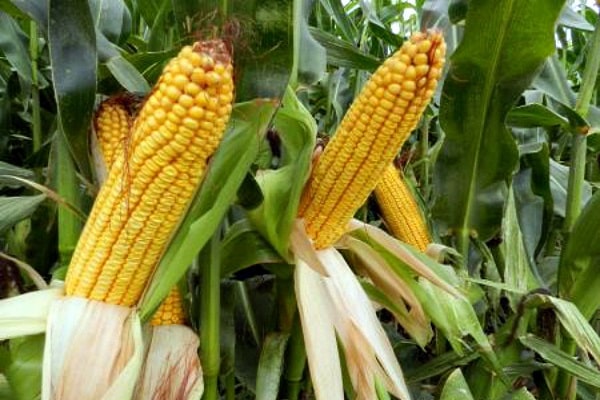
- The milky stage is distinguished by light whitish grains on the cob. They are high in sugars. If you press on the seeds, then a white, sweet juice will appear from them. They taste sweet, tender and juicy. The leaves fit snugly around the cob, and it becomes difficult to separate them. The hairs are soft, moist, brown at the base. It is better to pick such corn by hand. It can be eaten both raw and boiled.
- The onset of the waxy stage can be recognized by the light yellow color of the grains, inside of which there is no longer any liquid. They are of medium density to the touch, if you press on the seeds, they will dent. As it ripens, the density increases. The amount of starch in the grains increases. Sugar, which is part of the grains, begins to turn into starch, and the juice turns into pulp.
- Biological ripeness is distinguished by a rich yellow or orange color of the grains. Leaves, tight-fitting the cob, begin to turn yellow and dry, they are easy to separate. The hairs turn brown and dry. Corn at this stage of ripeness is harvested by a combine harvester, and the main purpose is considered to be the manufacture of silage for herbivorous domestic animals.
At the stage of grain formation, the moisture level is almost 90%. At the stage of milk ripeness, the moisture content of the grain in the cobs is 58%, during the period of waxy ripeness, the moisture content of the seeds is about 37%. When the corn is fully ripe, the grains become hard, and the moisture content is no more than 25%.
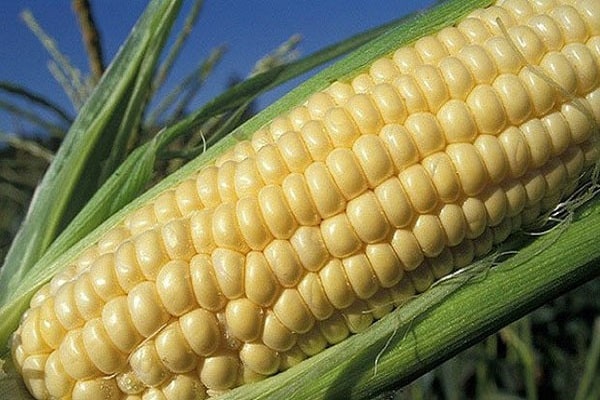
How to grow corn?
General rules to help you grow a good harvest.
| Air temperature | + 12-25 degrees |
| The soil | Should not be sour. Podzolic, peat and chernozem compositions with good aeration are best suited. |
| Predecessors | The best predecessors are cucumbers, potatoes, legumes, tomatoes, onions. |
| Fertilizers | In the fall, it is recommended to add potassium-phosphorus fertilizers and organic matter. The culture responds well to humus and compost.After unrolling 4 leaves, you can add nitrogen fertilization. Potassium and phosphorus are essential at all stages of development. |
| Watering | The culture needs abundant watering, especially during the period of seed germination and ear formation. |
| Pests | Wireworm, meadow moth, leaf scoop, swedish fly, root aphid. |
| Diseases | Rust, fusarium, powdery mildew, blister smut. |
The optimal dates have been developed, recommended for harvesting corn from the field. If you follow them, there will be minimal losses and high quality of the crop.
Crop losses in a corn field increase when harvested after frosts and when the air humidity rises. The grain picks up moisture, the ears become heavy, and as a result, the stems rot and bend. Collecting such ears with agricultural machinery becomes problematic.
There are two main harvesting methods:
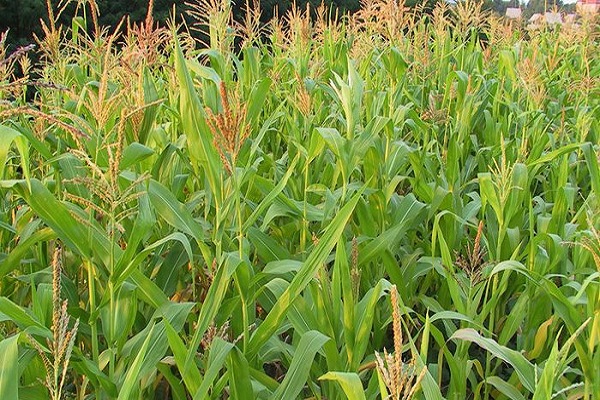
- cutting the ears, which can either be accompanied by leaf peeling or not;
- harvesting with simultaneous threshing of grain.
The mechanical grain processing unit allows you to harvest, thresh the ears and grind the plants. Harvesters are used for grain harvesting of crops (Khersonets, KOP-1, grain harvester with PPK-4 attachment). A header is also used in conjunction with this technique. It differs from other aggregates in that it is a small device for processing stems and leaves. For silage, corn is harvested with forage harvesters.
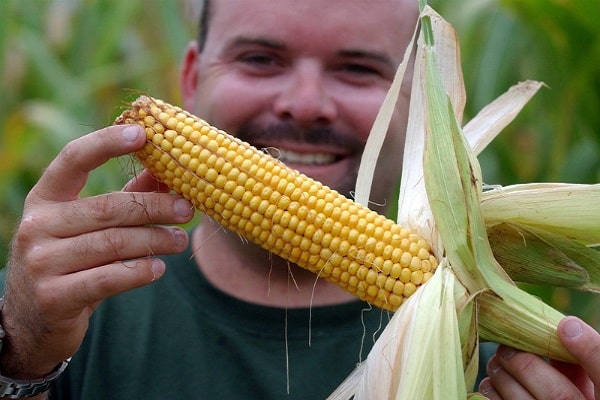
How do you know when it's time to harvest?
The ripening time of the crop depends on the variety, climatic and weather characteristics. Corn is harvested most often in early August, by this time corn silk takes on a brown tint.
Certain traits will help you harvest corn for fresh consumption. If the stigma inside the leaf is still greenish, and the outside is brownish, then the corn is in the milky-waxy stage of development. If you lightly press on the grain, then a milky, sweet juice will appear from it. The maximum amount of nutrients is concentrated in such ears, they can be consumed fresh or used for cooking.
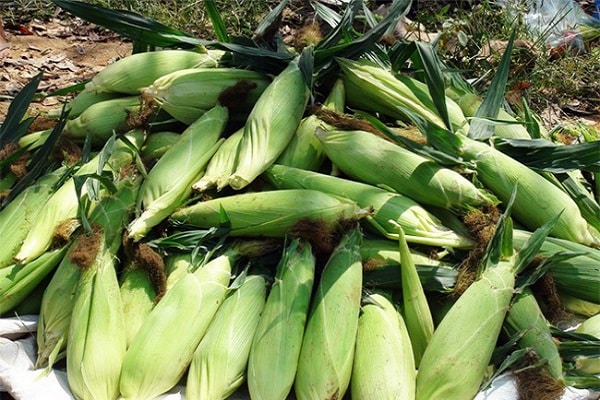
If the grain crop is intended for the production of silage, then the harvesting of corn begins after the onset of waxy ripeness. In the southern regions of the country, this period coincides with the last days of August. In some areas, cleaning may take place in November. By this time, the moisture content of the green mass can exceed 70%. For popcorn, the onset of biological ripeness is expected, when the grains become hard.
If corn is supposed to be used as planting material, it is recommended to wait until the leaves turn yellow and dry completely. The harvested crop is placed in a cool place for a month until fully ripe. Once the grains are completely dry, they are transferred to a dry, glass container.
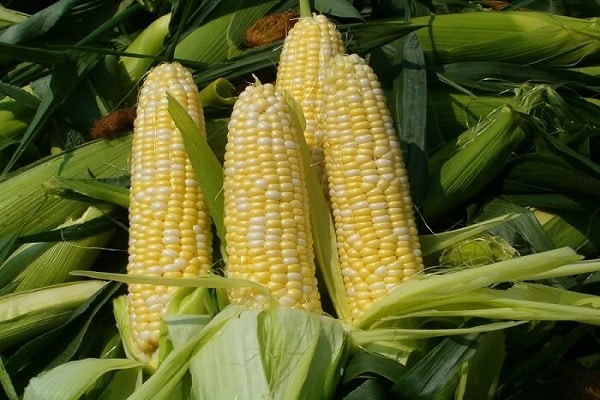
If the grains for planting do not have time to be collected before frost, then they lose their germination, and the risk of developing fungal diseases increases. As a result, the nutritional value and the amount of the crop are reduced.
Harvesting corn for fresh consumption
When growing corn, there are several signs of when to harvest. The main thing here is to guess the onset of milk ripeness. Signs:
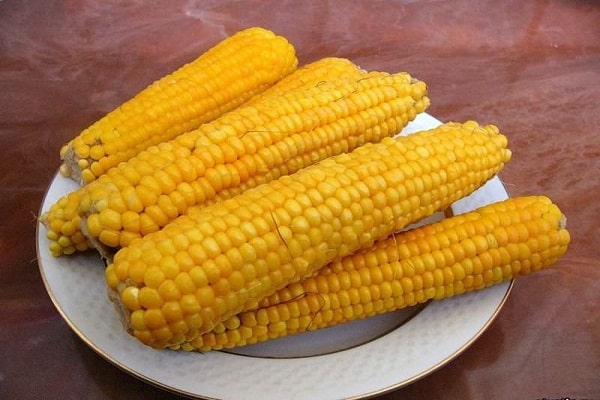
- The cobs deviate laterally from the stem. The leaves fit tightly around the ear, they are green.
- The cobs that are closer to the top are harvested first. They are the ones that ripen faster.
- The hair should be brown and dry. If they are moist and reddish, then the stage of milk maturity has not yet arrived.
- The seeds should be white-yellowish in color. When pressing on the grain, the juice should be white, not clear. If the juice becomes thick, and the color of the grains is dark yellow, then the stage of milk ripeness is missed.Such seeds lose their juiciness and sweetness.
- The ear can be easily separated from the stem by hand.
Since sugar quickly turns into starch, after harvesting the corn must be eaten, otherwise the taste and sweetness are lost. You can prolong the taste by placing the ears in the refrigerator.
The grain culture for grain is harvested on the cob or with simultaneous threshing of the cobs. For fresh consumption, the procedure does not make sense.
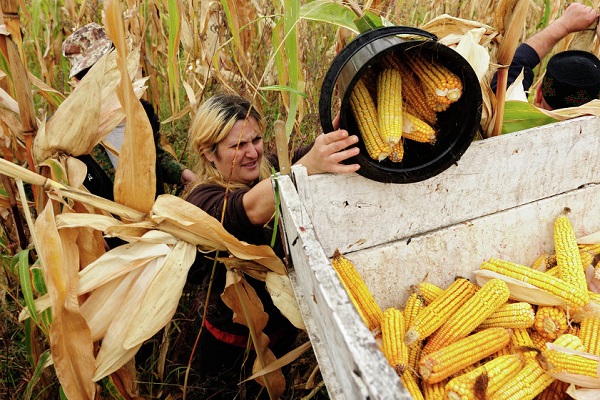
How to harvest popcorn corn?
For the production of popcorn, special varieties of popcorn are planted (Vulkan, Vnuchkina joy, Oerlikon, Gostinets).
Harvesting corn for popcorn is started only after the onset of the biological stage of maturity. By this time, the leaves and stems turn yellow, dry up, and the panicles acquire a dark brown hue.
It is imperative to harvest the crop before the onset of frost, otherwise the harvested corn will not be suitable for making popcorn. Better to pick off the cobs by hand.
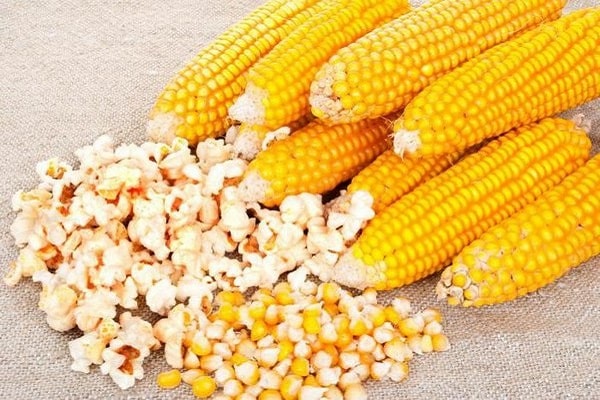
After harvesting grain corn, the cobs are peeled of leaves and spread on a cloth surface in a warm, dry place with good ventilation. The ears should remain partially moist inside.
To check the readiness of a grain crop for popcorn production, it is necessary to periodically reheat several grains in a pan. If the seeds open completely, then all the ears are ready. After that, the crop is moved to a cool place.
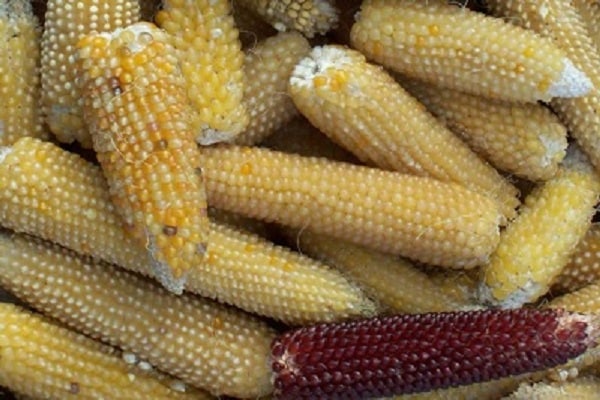
Collection of corn cobs for grain
The harvesting of corn for grain is carried out with special harvesters during the period of biological ripeness. At this point, the cob must have a dry matter of at least 60%, and in the grain at least 70%. The higher the dry matter content of the grain, the better. Corn varieties for grain: Spirit, Pioneer, Syngenta, Dobrynya, Trophy, Sundance.
You should not start harvesting when the moisture content of the grain is high. At this time, the level of various impurities increases, and the commercial quality of the products is lost.
During the harvesting of corn for grain, a number of agrotechnical requirements must be observed:

- you need to cut the plants at a distance of 15 cm from the ground;
- when harvesting with a grain harvester, you need to ensure that no more than 5-7% of the grains are damaged in the cob;
- if special harvesters are used, the number of damaged grains should not exceed 1.5%.
As a result of harvesting with a combine harvester, more than 90% of the ears are already cleared of leaves.
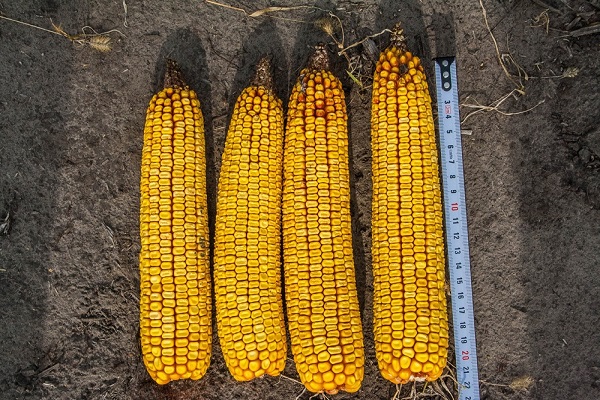
Features of harvesting corn for silage
The most valuable is corn on the cob, which is harvested at the end of the milk stage or at the beginning of waxy ripeness when the leaves are still green. These ears contain many useful components for livestock. The moisture content of the beans is about 70%.
They begin to harvest corn with special equipment. Permissible dry matter content 30%. The moisture content of the leaves should be at 68%, the moisture content in the grain - 45-50%. The plant is mowed at a distance of 20 cm from the ground, all parts of the plant, including the seeds, must be crushed. The size of the parts should not be more than 7 mm.
The resulting silage in the form of well-rammed briquettes is piled into prepared trenches. This will improve product quality and increase shelf life.
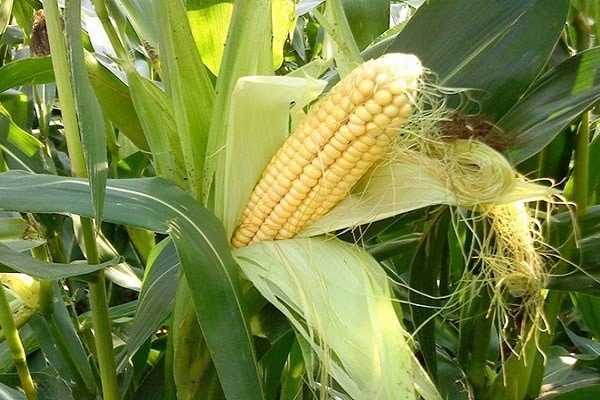
Nutritional value of corn seeds per 100 grams
100 g of corn seeds contain 360 kcal. Protein content 9 g, fat 5 g, carbohydrates 70 g, fiber 7 g. Nutrients include vitamins (vitamins of group B, vitamin A, vitamin C, vitamin E), micro- and macroelements (calcium, iron, magnesium, potassium) , amino acids (alanine, valine, methionine). In addition, it contains both saturated and unsaturated fatty acids.
The appearance of the plant will tell you when it is best to harvest the corn. The leaves turn light green, the edges dry out. The ears are collected selectively, as they do not all ripen at the same time. The collection takes about two weeks.Don't pick the cobs too early or too late.

Store corn can be on the cob. The ears should be kept in a cool, dark place, where the air humidity is no more than 15%. The ears are cleaned of leaves, sorted out and dried. The bulk of the harvested grain on dry ears should be easily separated from the base.
You can also store it in grain. With this method of storage, you need to prepare plastic or glass containers, cardboard boxes or cloth bags in advance.
Store corn in seeds in a cool place protected from pests and diseases. If the grains are supposed to be used as planting material, then it is better to pick the cobs by hand.
